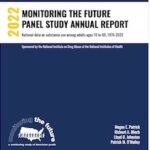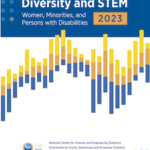 All Entries in the "Gender Gap" Category
All Entries in the "Gender Gap" Category

The Persisting Gender Gap in Poverty Rates in the United States
Overall, there were more than 20 million American women and girls who were living below the poverty level in 2022. In 2022, 12.5 percent of all women and girls in the United States lived in poverty compared to 10.5 percent of men.

Study Finds Women Ask for Raises and Promotions At Similar or Higher Rates Than Men
A new study by women scholars at the University of California, Berkeley and Vanderbilt University in Nashville debunks the gender pay gap myth that “women don’t ask for raises.” The study found that women attempt salary negotiations as much or more than men do, but are more likely to be rejected.

Nearly Four-Fifths of the Graduates Who Hold the 20 Highest-Paying Bachelor’s Degrees Are Men
A new study by Bankrate finds that nearly 4 in 5 (78 percent) of those who hold the 20 most lucrative bachelor’s degrees are men, while only 22 percent are women. Of the 20 most common majors for women, only those with a nursing degree earn a median salary higher than $60,000.

Differences in Substance Use by Men and Women College Students
College women were more likely than college men to use marijuana or consume alcohol over the 30 days prior to the survey. But college men were more likely than college women to be heavy drinkers, smoke cigarettes, and use hallucinogens and cocaine.

University Study Finds a Narrowing of the Gender Gap in Alcohol Related Deaths
Previous research has shown that women are drinking more, engaging in more high-risk drinking, and increasingly developing alcohol-use disorders. But a new study, led by Ibraheem M. Karaye, an assistant professor of population health, and director of the health science program at Hofstra University in Hempstead, New York, finds a sharp rise in alcohol-related deaths among women.

Gender Differences in Financial Aid Awards
Despite the fact that women were more likely than men to receive grants, on average women received lower amounts. The average grant given to women was $8,900 compared to $9,700 for men. The average loan amounts were nearly equal for men and women students.

Women of Color Are Scarce in STEM Higher Education and the Workforce
A new report from The Education Trust shows that vast disparities in attainment by race, ethnicity, and gender persist in STEM education and employment, thereby limiting access and opportunities for social and economic mobility for some — particularly women and people of color.

The Persisting Gender Gap in Weekly Earnings
A new report from the Bureau of Labor Statistics finds that the median weekly earnings of the nation’s 121.5 million full-time wage and salary workers were $1,100 in the second quarter of 2023. But there is a persisting gender gap in earnings. Women had median weekly earnings of $993, or 84.1 percent of the $1,181 median for men.

Women Are Slower Than Men on the Path From Mentored to Independent Research in the Biomedical Sciences
Researchers examined the percentage of men and women who received National Institute of Health early career awards which included a mentored component over a 10-year period. They then looked at how many of these men and women received R01-equivalent awards (a class of grants that fund specific research projects and provide around $500,000 per year for multiple years) over the next 10-year period. Women trailed men in the transition to the more significant grants.

Women Continue to Face Bias When Seeking Employment in the Tech Industry
A new study by Hired, an online job placement firm based in New York City, finds that women continue to face bias when seeking employment in the tech industry. The survey found that in 38 percent of the jobs posted for tech jobs, only men were sent interview requests for the positions.

Stanford University Study Finds a Gender Gap in Academic Authors Who Get to Share in Patents
New research undertaken by an interdisciplinary team of Stanford Law and Stanford Medicine students, looks at the overlap between biomedical research paper authors and those authors who go on to be named inventors of their research on patents. Among the findings is a gender discrepancy between male and female authors, with male authors receiving patents more frequently.

Little Progress in Advancing Women in STEM Jobs in the Federal Workforce
The researchers found that on average, fewer than one in four STEM jobs were held by women in the Air Force, Army, Navy, the departments of Energy and Transportation, and NASA. Women account for less than 30 percent of STEM jobs in the departments of Veterans Affairs, State, Interior, Homeland Security, Defense, and Commerce.

A Snapshot of Gender Disparities in Legal Education
In 2022, 68 percent of women applicants who applied to law school were accepted to at least one law school. In contrast, 71 percent of all male applicants were accepted to a law school. Women made up 56 percent of all law school enrollments.

The Gender Gap in Leadership Positions at the Nation’s Leading Research Universities
A new report from the EOS Foundation finds that women now lead 30 percent of all R1 research universities in the United States. This is up from 22 percent just two years ago. Between September 2021 and May 2023, half of the newly appointed presidents were women.

A Snapshot of the Gender Diversity of the Faculty at Johns Hopkins University
The university reports that in 2021, there were more than 2,400 women faculty at the university. They made up 46 percent of the more than 5,200 faculty members. In 2015, women were 42 percent of all faculty at Johns Hopkins. There were 340 women full professors. They made up 28.1 percent of all full professors.

The Widening Gender Gap in College Aspirations
A new survey by YouthTruth looks at the college plans of the high school class of 2023. Some 77 percent of female high school seniors believe they will actually enroll in college. For males, only 57 percent thought they would actually enroll. That’s a 20 percentage point gender gap among college seniors who think they will enroll in college.

How Artificial Intelligence Can Narrow the Gender Gap in STEM Fields
A new study by researchers at Monash University in Melbourne, Australia, and the University of Gothenburg in Sweden, finds that the use of artificial intelligence in recruitment changes the gender distribution of potential hires, in some cases more than doubling the fraction of top applicants that are women.

A Study of 1.3 Million Grant Applications Worldwide Finds a Substantial Gender Gap In Research Funding
Women researchers received substantially less funding in grant awards than men — an average of about $342,000 compared to men’s $659,000, according to a large meta-analysis of studies led by Karen Schmaling, a psychology professor at Washington State University, Vancouver.

A Significant Narrowing of the Gender Gap in Home Ownership Rates
Today, the homeownership rate of households headed by women has reached 63 percent — just 5 percentage points below the men’s rate, down from 20 percentage points in 1990. Despite making up a higher share of college graduates, single female household heads still lag behind their male counterparts in homeownership.

Women Are Only One Third of Participants in Exercise Science Studies Published in Major Journals
The authors found that when a man was the lead author of a study in research relating to exercise science, the level of women participants in the study was lower. When there was a woman lead author, survey participants tended to be equally divided between men and women.

Can the Gender Pay Gap Be Partly Explained by a Reluctance of Women to Ask for Higher Pay?
Some observers have speculated that one explanation for the gender pay gap is that women are less likely than men to negotiate with their employers for higher pay. But a new report from the Pew Research Center finds that women are almost as likely as men to ask for a higher salary than was originally offered by a new employer.

Study Finds a Major Gender Gap in Homeownership Rates Among Single Young Adults
A new report from Zillow, the online real estate marketplace, finds that the single women’s homeownership rate declined in 2022 for the first time since 2016. In 2021, the gap was only 1.8 percentage points. But in 2022, the homeownership rate for single women was 24.5 percent compared to a 33.1 percent rate for single men.

A Persisting Gender Pay Gap in Teacher Compensation in the Public Schools
A new study by the Brookings Institution finds that although women make up roughly three–quarters of the teaching workforce, they make an estimated $5,000 less than men annually, Much of the gap is explained by men doing extra work – such as coaching – and being more likely to get paid for this extra work than women.

How Colleges and Universities Can Impact the Gender Gap in the Tech Workforce
A new study by Accenture, the consulting and technology services company based in Dublin, Ireland, has issued a new report that finds that the proportion of women to men in tech roles has declined over the past 35 years. And half of all young women who go into tech drop out by the age of 35.

Women Underrepresented Among “Super Principal Investigators” on NIH Grant Projects
Super principal investigators are researchers who received three or more concurrent grants from the National Institutes of Health. Women were significantly underrepresented among SPIs, even after adjusting for career stage and degree. Women were 26.6 percent of all super principal investigators in 2020. They were 34 percent less likely than their male colleagues to be an SPI.

College Athletic Powerhouses Receive a Grade of F in Gender Equity in Leadership Posts
In the Fall of 2022, there were 30 women who served as president or chancellor of the 130 educational institutions that make up the Football Bowl Subdivision of Division I of the National Collegiate Athletic Association. Women were only 7.7 percent of all directors of athletics at these colleges and universities

The Snail-Like Progress of Women Into the Executive Suite at the Nation’s Largest Companies
A new study by USA Today finds that of the 533 executive officers at the nation’s largest firms, there were 90 women. They made up 17 percent of the total. Women of color made up just one percent of all executive officers at these firms.

Women Making Progress in STEM Education and Occupations, But More Work Needs to Be Done
The number of science and engineering degrees earned by women between 2011 and 2020 increased by 63 percent at the associate’s level, 34 percent at the bachelor’s level, 45 percent at the master’s degree level, and 18 percent at the doctorate level. But in 2021 women, who were 51 percent of the population, represented about one-third of the STEM workforce.

Study Examines How an Academic Department’s Gender Composition Impacts Teacher Evaluations
A new study led by Oriana Aragón, an assistant professor of marketing in the College of Business at the University of Cincinnati, finds that professors in the gender minority of university academic departments tend to receive lower scores in their performance evaluations because of gender bias.

Women Make Up a Tiny Percentage of Editors of Scientific Journals
A new study led by researchers at New York University Abu Dhabi examined the gender disparity in the makeup of editorial boards of scientific journals. The researchers used algorithmic tools to infer the gender of 81,000 editors serving more than 1,000 journals and 15 disciplines over five decades. The results show that only 14 percent of the editors were women. Only 8 percent of editors-in-chief were women.

American Association of University Women Updates Its Report on the Gender Pay Gap
Using data from the U.S. Census Bureau and the U.S. Bureau of Labor Statistics, the AAUW calculated that in 2021 women were paid just 84 cents for every dollar paid to men when comparing full-time, year-round workers. However, when the calculation included all workers, the earnings discrepancy is substantially larger: Women took home only 77 cents for every dollar men did.

San Diego State University Scholar Finds Women Are Vastly Underrepresented in Behind-the-Scenes Roles in Hollywood
A study by Martha M. Lauzen, a professor and executive director of the Center for the Study of Women in Television and Film at San Diego State University, found that in 2022, women comprised 24 percent of directors, writers, producers, executive producers, editors, and cinematographers working on the top 250 grossing films. This represents a decline of 1 percentage point from 2021.

Gender Differences in Enrollments in Post-Pandemic Higher Education
In October 2021, there were 10,061,000 women enrolled in higher education in the United States. They made up 58.1 percent of all enrollments in higher education. Women were 58.3 percent of all students entering graduate school in the fall of 2021. They were 57.8 percent of all students in their second or more years in graduate school.

Workplace Fatalities for Women Increased Sharply in 2021
While women make up a low percentage of all work-related fatalities due to injuries, the number of deaths of women has been increasing. While women were just 8.6 percent of all work-related fatalities, they made up 14.5 percent of fatalities as a result of intentional injuries inflicted by a person in 2021.

Women Continue to Make Gains in Medical School Enrollments
The number of women first-year students at U.S. medical schools in 2022 increased slightly, to 12,630. Women made up 55.6 percent of all first-year students in U.S. medical schools. In 2022, there were 51,890 women students enrolled at U.S. medical schools. They made up 53.8 percent of all medical school students.








